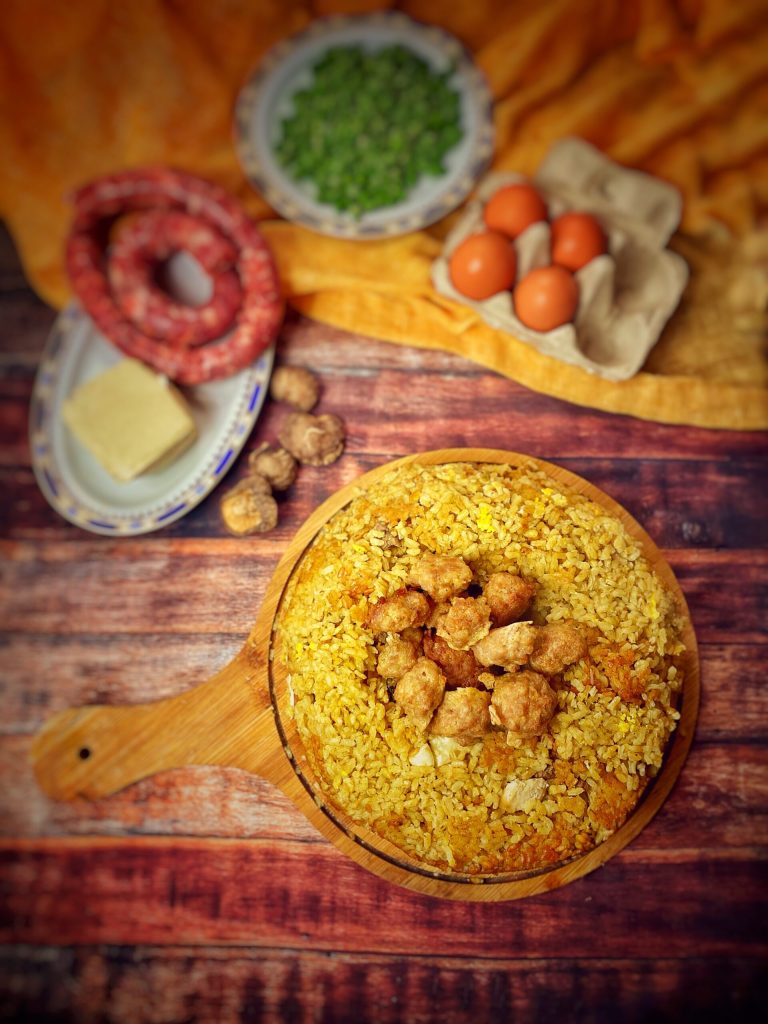The Fusion Rice Sartù is a fusion cuisine ‘experiment’ based on a traditional Italian recipe: Neapolitan rice sartù.
Rice first arrived in the city of Naples at the end of the 14th century from Spain, in the holds of Aragonese ships. It was the time of epidemics, and it was prescribed as food for the sick.
It was in the 18th century, during the reign of Ferdinand I of Bourbon, King of the Two Sicilies, that Rice Sartù was born.
When Ferdinand I married Maria Carolina of Austria, at the behest of his wife, who did not like Neapolitan cuisine, refined French chefs were called to the court, and knowing the Neapolitans’ aversion to rice, decided to make it more appetizing.
They added ‘a pummarola, peas, hard-boiled eggs, fior di latte, meatballs, and sausage.
The term sartù is actually a distortion of the French term “sortout”, the centerpiece used in the 18th century, which could also be used to serve the sartù, or to indicate the “above all” or the special “breadcrumb coat” under which the ingredients are placed, inside a rice timbale.
Today, there are two versions of sartù: a white version – the one that follows – and a red one, and the internal ingredients can vary according to taste, although in addition to those already mentioned, there are always: Neapolitan ragù (white or red), bacon, and mushrooms.
In the past, chicken livers were also used, and as fat, lard or sugna.
My white fusion version has an oriental hint and replaces the fior di latte (or provola) with silken tofu, for the Tofu Menu, from the column “Build the Menu”, lard with Indian ghee, Mediterranean dried mushrooms with shiitake mushrooms, white wine with sake, meat broth with miso.
Usually, a cone or donut-shaped mold of 9.5/10 inches is used.

- Difficulty: Difficult
- Cost: Medium
- Preparation time: 2 Hours
- Portions: 6 people
- Cooking methods: Stovetop, Oven, Frying
- Cuisine: Fusion
- Seasonality: All seasons
Ingredients
- 1 onion
- 7 oz beef (muscle)
- 3.5 oz sausage
- 2 pork ribs
- 1/2 glass sake
- 1 cup peas
- 1 oz shiitake mushrooms
- to taste salt
- 14 oz mixed ground meat
- 3 tablespoons pecorino
- 1 egg
- to taste breadcrumbs
- 2 tablespoons rice flour
- to taste seed oil
- to taste salt and pepper
- 18 oz Carnaroli rice
- 1 tablespoon miso
- 6 tablespoons pecorino
- 3 eggs
- to taste breadcrumbs
- to taste butter
- 4 hard-boiled eggs
- 12 oz silken tofu
- 7 oz bacon (diced)
Tools
- 1 Mold cone-shaped
Steps
For the white ragù: Sauté the onion in ghee, add the finely chopped meat, sausage, pork ribs, peas, mushrooms after soaking them in hot water for a few minutes and chopping them (700 gr tomato puree for the red version), deglaze with sake, add a glass of water, and cook for about 1.5 hours. Adjust the salt.
Check and add more water if necessary.
If you use chicken livers, brown them in lard with bay leaf and a little broth.
For the meatballs: Add the pecorino, egg, breadcrumbs, and rice flour to the minced meat. Adjust salt and pepper. Form small meatballs and fry them in a pan with oil.

For the rice: Toast the rice, cook for 17 minutes by adding broth with miso (2 liters of water in which a tablespoon of miso has been dissolved at the time of boiling). Finally, stir in the grated pecorino.
Turn off, add the eggs, and let it cool down.
Butter and breadcrumb the mold, add a part of the rice, then break up the hard-boiled eggs, add the ragù, (chicken livers), 1/3 of the meatballs, tofu, bacon, cover with the remaining rice, and bake at 350°F for 40/45 minutes.
Let it cool before flipping over very carefully.
Serve with the remaining meatballs on top.

FAQ (Questions and Answers)
What is fusion cuisine?
A type of cuisine that combines elements from different culinary traditions to create new and innovative dishes.
Fusion cuisine should not just be a mix of flavors incorporated into a dish without any logic, but should harmonically incorporate tastes from different origins.
It is possible to identify three different types of fusion cuisine.
The first type, literally fuses culinary styles from various cultures, giving birth to new inventions.
Then there is the more “commercial” one that takes the name of the culinary art of one country and transfers it to another: for example, an Italian restaurant in America that offers dishes from our tradition revisited according to American taste (see the dedicated article on The recipes of the TV series The Bear).
The third type unites ingredients from different geographical areas, associated in the creation of a new tradition: the most famous example is the Tex-Mex cuisine.

